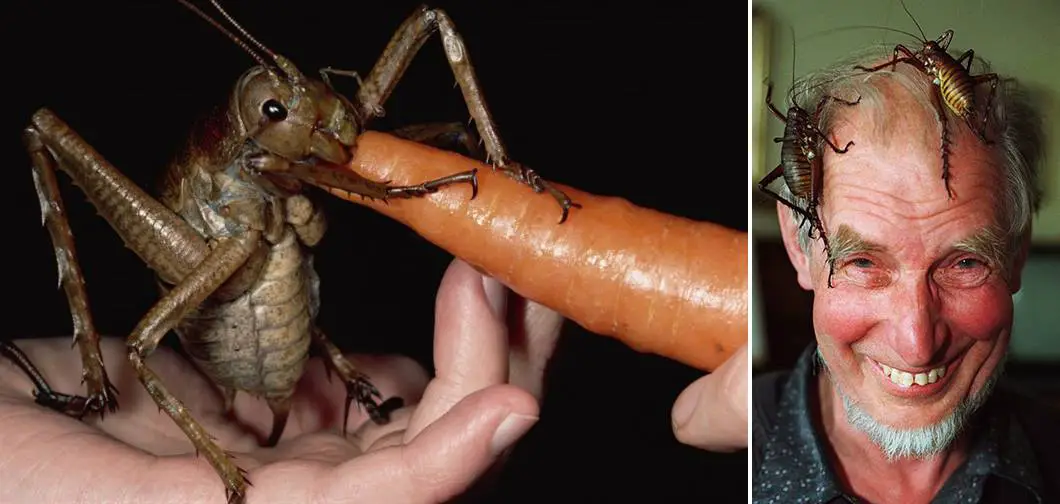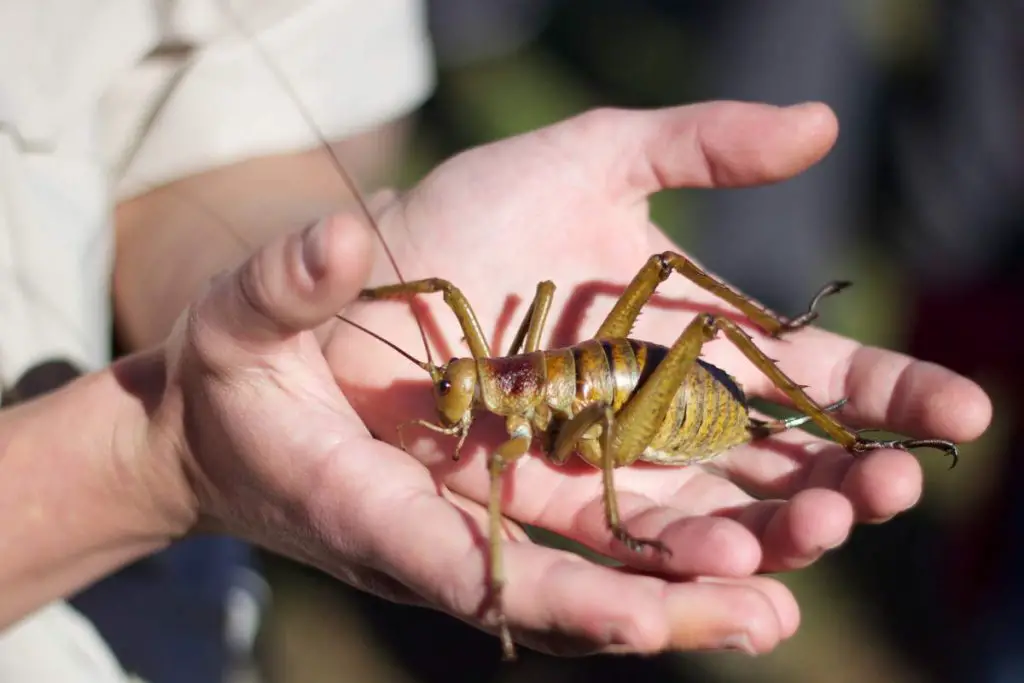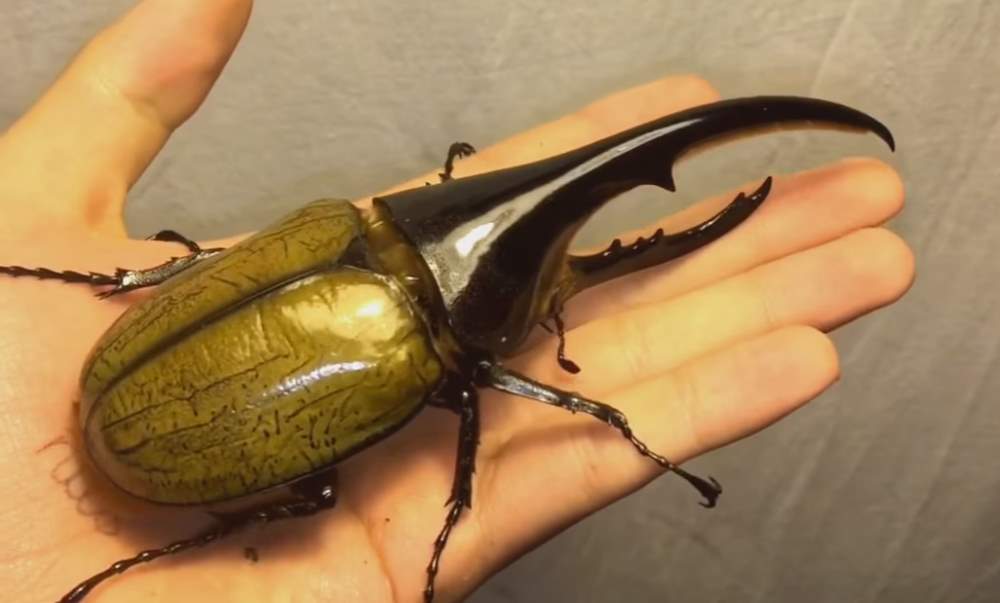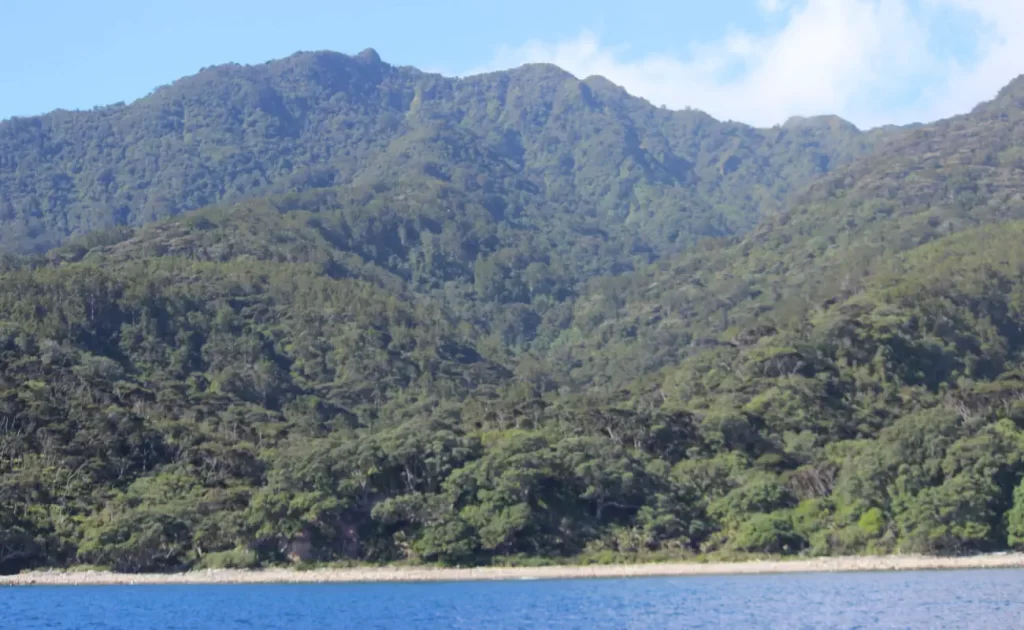In the small islands of New Zealand,
Giant weta is the heaviest insect on Earth. Fully grown species can even be heavier than a mouse or sparrow.
Giant weta is endemic to New Zealand and is an example of island gigantism, which is a biological phenomenon leading to a larger size than their mainland relatives because of their isolation and lack of large predators. A female giant weta filled with eggs can reach up to 70 grams (2.47 oz.) or more!

Giant weta
There are eleven species of giant wētā, most of which are larger than other wētā, despite the latter already being large by insect standards.
The largest species is the Little Barrier Island giant weta. Large specimens can be up to 10 centimeters (4 inches) not inclusive of legs and antennae, with body mass usually no more than 35 grams. But rarely, a female filled with eggs can reach up to 70 grams or more: one captive female reached a mass of about 70 grams (2.5 oz.), making it one of the heaviest documented insects in the world and even heavier than a sparrow.
The largest species of giant weta is the Little Barrier Island giant weta, also known as the wētāpunga, which means the “god of ugly things” in the Maori language. One example reported in 2011 weighed 71 grams, and a 72 grams specimen has been recorded.

Giant wētā facts
1. The Giant wētā is the heaviest insect on Earth
As explained above, the Giant wētā is the heaviest insect on Earth. In fact, they usually do not exceed 35 grams (1.23 oz.), but even this outweighs many sparrows and mice. Some individuals (females filled with eggs) can grow as heavy as 70 grams (2.47 oz.) or more!
2. They are big
Large individuals can grow up to 10 centimeters (4 inches), and this length does not include legs and antennae.

Related: Top 10 Largest Insects on Earth
3. They live only in the Little Barrier Island, New Zealand
Although wētāpunga once lived across Northland, Auckland, and Great Barrier Island (Aotea), now they can only be found in Little Barrier Island.
Little Barrier Island (Hauturu in the Māori language, means “the resting place of the wind”), lies off the northeastern coast of New Zealand’s North Island. Located 80 kilometers (50 miles) to the north of Auckland, the island is separated from the mainland to the west by Jellicoe Channel, and from the larger Great Barrier Island to the east by Cradock Channel.
The island is an extinct andesitic volcanic cone, roughly circular in shape, about 6 kilometers (3.7 miles) across, with an area of 28 km2 (10.8 square miles).

Approximately 40 species of rare or endangered birds, 14 reptiles, 2 bat species, and more than 400 native plants live in the Little Barrier Island, according to the New Zealand Department of Conservation (DOC).
Visitors need a permit from the DOC before visiting the island.
4. They are not very social
The giant weta is usually less social and more passive than other weta species. Their genus name, Deinacrida, is Greek for “fierce grasshopper”. Its diet consists of plants (even carrots!), other small insects, and fruit.
5. They are short-lived
Like many other insects, they are short-lived: they only walk on Earth for about 6-9 months. During this time, they mate repeatedly.
6. Giant wētā is omnivorous
They are mainly herbivorous in the wild but are also known to eat other insects.
7. They are on the brink of extinction
The amazing Giant wētā has been around for 190 million years. But, unfortunately, now it is on the brink of extinction.
Most populations of this amazing insect have been in decline since humans began modifying the New Zealand environment. All but one giant weta species are protected by law because they are considered at risk of extinction. When humans arrived in New Zealand hundreds of years ago, they inadvertently brought the weta predators along with them, like rats and cats, which ate the insects.
To help safeguard this threatened species, an experimental breeding project was successfully undertaken by the staff at Butterfly Creek in South Auckland under the guidance of the Weta Recovery Group. Auckland Zoo was extremely successful at breeding hundreds of wētāpunga.
8. They can’t fly – they even can’t jump
Despite having big, strong legs, Giant wētā cannot jump.
Some of its lighter relatives are more agile and can jump, for example, the tree wētā.
Many wētā species are alpine specialists (live in high altitudes). Five species are only found at high elevations in South Island. The scree weta (D. connectens) lives about ~1200 meters (3,920 feet) above the sea level and freezes solid when temperatures drop below -5°C (23°F).
9. They have a powerful bite
Giant wētā has a very powerful bite (as explained above, they can even eat carrots) and a bite can be very painful. But it’s not common, they do not aggressive, and tend to retreat if given the chance.
10. They are nocturnal
They are active at night. they usually hide in dead foliage during the day.
Sources
- Giant weta on Wikipedia
- “10 Intense Facts About the Giant Weta” on Mental Floss
- Wētāpunga on the New Zealand Government Department of Conversation webpage
- “Te Hauturu-o-Toi / Little Barrier Island Nature Reserve” on the New Zealand Department of Conservation official website
- How Many Elephants are Left in the World in 2025? - August 17, 2025
- Moon Landings: All-Time List [1966-2025] - February 2, 2025
- What Is Max-Q and Why Is It Important During Rocket Launches? - January 16, 2025

One reply on “Giant Weta: the heaviest insect on Earth [10 amazing giant weta facts]”
What a great video! I never heard of the giant Weta before. Very informative, and so interesting. I hope they will successfully flourish as they once were. It’s so important to have these programs to keep our eco system in checks and balances.
What a great way also to encourage the children the importance of the Weta and other insects.